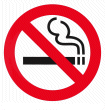The World Health Organization has been studying smoking
trends and statistical patterns across the globe and has
come up with the following statistics:
A good deal of variation exists from one part of the world
to another. Many more women smoke in Eastern Europe than
in East Asia and the Pacific Region. Eastern Europe itself
has a particularly high rate of smoking, with up to 59 percent
of adult males smoking.
As with other substances of abuse, such as alcohol and
cocaine, the global frequency of tobacco use varies by social
class, historical era, and culture. Historically, smoking
had been a pastime of the rich. This trend has changed dramatically
in recent decades. It appears that economically advantaged
men in wealthier countries have been smoking less. The more
years of education you've had, the less likely you are to
be a smoker.
Most smokers begin early in life, before they are 25 years
old. According to World Health Organization studies, the
majority of smokers in affluent countries begin in their
teens. A decline in the age of starting smoking has been
observed worldwide.
As a wannabe quitter, you're in excellent company. People
all over the world are trying to quit and stay away from
cigarettes. There appears to be a correlation between a
country's standard of living, level of education, and income
and the number of people who have quit smoking. The more
and better-informed people are, the more likely they are
to quit smoking.
Current estimates are that over 1 billion people in the
world smoke. (In other words, approximately one in three
adults on the planet smokes.) The majority of these smokers
reside in countries on the low end to the middle of the
socioeconomic spectrum. Of this majority, about 80% live
in low and middle income countries. The total number of
smokers worldwide is expected to keep increasing.
But are things in the USA any better? Not really, as you
can see for yourself in the figures of National Health Interview
Survey (NHIS), Centers for Disease Control and Prevention,
National Center for Health Statistics
In the United States, an estimated 25.6 million men (25.2%)
and 22.6 million women (20.7%) are smokers. These people
are at higher risk of heart attack and stroke. The latest
estimates for persons age 18 and older show:
- Among whites, 25.1 percent of men and 21.7 percent of
women smoke
- Among black or African Americans, 27.6 percent of men
and 18.0 percent of women smoke
- Among Hispanics/Latinos, 23.2 percent of men and 12.5
percent of women smoke
- Among Asians (only), 21.3 percent of men and 6.9 percent
of women smoke
- Among American Indians/Alaska Natives (only), 32.0 percent
of men and 36.9 percent of women smoke
Studies show that smoking prevalence is higher among those
with 9-11 years of education (35.4 percent) compared with
those with more than 16 years of education (11.6 percent).
It's highest among persons living below the poverty level
(33.3 percent).
And These Figures Spell Death...
·One out of every five deaths is caused by tobacco
·An average of 400,000 Americans die each year from tobacco
·Tobacco is blamed for many serious pulmonary and cardiovascular
diseases
·Tobacco and nicotine are some of the most potent carcinogens
and are to blame for a majority of all cancers of the lung,
trachea, bronchus, larynx, and esophagus
·Tobacco use also produces cancers in the pancreas, kidney,
bladder, and cervix
·Impotency is sometimes to blame from addiction to nicotine
because of its ability to reduce blood flow
·Smoking is an important risk factor for respiratory illnesses,
causing 85,000 deaths per year from pulmonary diseases such
as chronic obstructive pulmonary disease and pneumonia
·Children and adolescents who are active smokers will have
increasingly severe respiratory illness, as they grow older
·Smoking during pregnancy causes about 5-6% of prenatal
deaths, 17-26% of low-birth-weight births, and 7-10% of
pre-term deliveries, and it increases the risk of miscarriage
and fetal growth retardation
·Cigarettes are responsible for about 25% of deaths from
residential fires, causing nearly 1,000 fire-related deaths
and 3,300 injuries each year
So, are you ready to try and quit smoking now?
Visit http://www.health-and-fitness-information.com/Quit-Smoking/
to learn how you can finally quit smoking fast, easily,
and all naturally!









